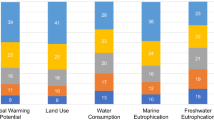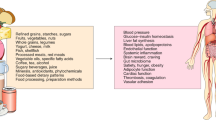Abstract
We aimed to develop a cost-free and sustainable program to influence healthier eating decisions during elementary school lunch. Baseline food and beverage choices were assessed for 9 days during lunch service at two racially and economically diverse elementary schools in Spartanburg County, SC, USA. After being informed that the labeled items on the daily lunch menu represented the healthiest choice, students were allowed to ring a call bell in the cafeteria for public recognition when they chose all of the identified healthiest food and beverage items during lunch service. Using menus matched to the baseline phase, food and beverage choices were measured during a 9-day intervention phase. After 30 days, food and beverage choices were reassessed during a 3-day follow-up phase. Healthiest food & beverage choices increased 49% with >60% of students choosing non-flavored milk over flavored milk during the intervention phase. There was no difference in the success of the program between the two schools. The program continued and healthy eating decisions were significantly sustained at a 30-day follow-up assessment. Public recognition through bell ringing appears to be an effective practice to sustain increases in healthy eating decisions during elementary school lunch and warrants expansion to larger scale, longitudinal trials.
This is a preview of subscription content, access via your institution
Access options
Subscribe to this journal
Receive 12 print issues and online access
$259.00 per year
only $21.58 per issue
Buy this article
- Purchase on Springer Link
- Instant access to full article PDF
Prices may be subject to local taxes which are calculated during checkout


Similar content being viewed by others
References
Lobstein T, Baur L, Uauy R, IASO International Obesity TaskForce. Obesity in children and young people: a crisis in public health. Obes Rev 2004; 5 (Suppl 1): 4–104.
Ogden CL, Carroll MD, Curtin LR, Lamb MM, Flegal KM . Prevalence of high body mass index in US children and adolescents, 2007–2008. JAMA 2010; 303: 242–249.
Child and Adolescent Health Measurement Initiative. 2007 National Survey of Children's Health. http://www.childhealthdata.org/ (accessed 13 July 2011).
Datar A, Sturm R, Magnabosco JL . Childhood overweight and academic performance: National study of kindergartners and first-graders. Obes Res 2004; 12: 58–68.
Pyle SA, Sharkey J, Yetter G, Felix E, Furlong MJ, Poston WSC . Fighting an epidemic: the role of schools in reducing childhood obesity. Psychol Sch 2006; 43: 361–376.
Dietz WH . Childhood weight affects adult morbidity and mortality. J Nutr 1998; 128: 411–414.
Katz DL, O’Connell M, Njike VY, Yeh MC, Nawaz H . Strategies for the prevention and control of obesity in the school setting: systematic review and meta-analysis. Int J Obes 2008; 32: 1780–1789.
Durant N, Baskin ML, Thomas O, Allison DB . School-based obesity treatment and prevention programs: all in all, just another brick in the wall? Int J Obes 2008; 32: 1747–1751.
Concanno K . Nutrition Standards in the National School Lunch and School Breakfast Programs; Proposed Rule. Federal Register 2011; 76: 2493–2570.
Letter to CDC Director Thomas Frieden. http://www.idfa.org/files/CDC%20letter.pdf (accessed 13 July 2011).
Patterson J, Saidel M . The removal of flavored milk in schools results in a reduction in total milk purchases in all grades, K-12. J Am Diet Assoc 2009; 109: A97.2.
U.S. Department of Agriculture, Food and Nutrition Service, Office of Research. Nutrition and Analysis, School Nutrition Dietary Assessment Study-III, Vol. I: School Foodservice, School Food Environment, and Meals Offered and Served, by Anne Gordon, et al. Project Officer, Patricia McKinney: Alexandria, VA, 2007.
Deci EL, Koestner R, Ryan RM . Extrinsic rewards and intrinsic motivation in education: reconsidered once again. Rev Educ Res 2001; 71: 1–27.
Pittman DW . Educational Video for Elementary School Students. Healthy Eating Decisions Program. http://youtu.be/roiVXgfkbo8 (accessed 13 July 2011).
Acknowledgements
We thank Susan Thomas, Emily Sheenan, Erica Samples, Covington Avent, Dominique Cox, Taylor Fenig, Bianca Harmon and Gwendolyn McDaniel for their assistance in data collection. We thank Peggy Luther and Ron Jones at Chartwells and the teachers, staff, principals and superintendent of the elementary schools for their cooperation and partnership. This study was approved by the Institutional Review Boards of Wofford College and the University of South Carolina-Upstate and supported by the Spartanburg Community Indicators Project, Spartanburg Regional Healthcare System Foundation and Wofford College. Supplementary information and instructions on how to implement this program in an elementary school along with a free multimedia tool kit are available at www.HealthyEatingDecisions.com.
Author information
Authors and Affiliations
Corresponding author
Ethics declarations
Competing interests
The authors declare no conflict of interest.
Rights and permissions
About this article
Cite this article
Pittman, D., Parker, J., Getz, B. et al. Cost-free and sustainable incentive increases healthy eating decisions during elementary school lunch. Int J Obes 36, 76–79 (2012). https://doi.org/10.1038/ijo.2011.205
Received:
Revised:
Accepted:
Published:
Issue Date:
DOI: https://doi.org/10.1038/ijo.2011.205
Keywords
This article is cited by
-
Design and rationale for evaluating the impact of salad bars on elementary school students’ fruit, vegetable, and energy intake: a wait list control, cluster randomized controlled trial
BMC Public Health (2022)
-
Cafeteria assessment for elementary schools (CAFES): development, reliability testing, and predictive validity analysis
BMC Public Health (2018)



